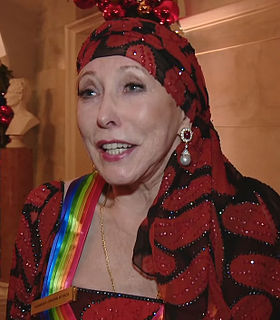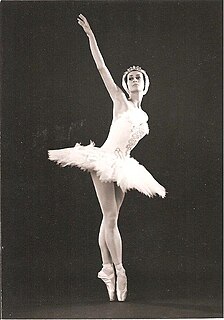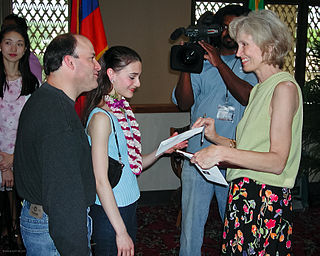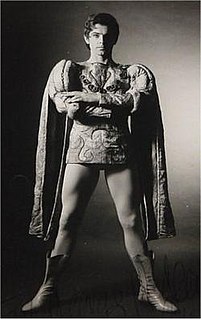Related Research Articles

Dame Margaret Evelyn de Arias DBE, known by the stage name Margot Fonteyn, was an English ballerina. She spent her entire career as a dancer with the Royal Ballet, eventually being appointed prima ballerina assoluta of the company by Queen Elizabeth II. Beginning ballet lessons at the age of four, she studied in England and China, where her father was transferred for his work. Her training in Shanghai was with Russian expatriate dancer Georgy Goncharov, contributing to her continuing interest in Russian ballet. Returning to London at the age of 14, she was invited to join the Vic-Wells Ballet School by Ninette de Valois. She succeeded Alicia Markova as prima ballerina of the company in 1935. The Vic-Wells choreographer, Sir Frederick Ashton, wrote numerous parts for Fonteyn and her partner, Robert Helpmann, with whom she danced from the 1930s to the 1940s.

Dame Alicia Markova DBE was a British ballerina and a choreographer, director and teacher of classical ballet. Most noted for her career with Sergei Diaghilev's Ballets Russes and touring internationally, she was widely considered to be one of the greatest classical ballet dancers of the twentieth century. She was the first British dancer to become the principal dancer of a ballet company and, with Dame Margot Fonteyn, is one of only two English dancers to be recognised as a prima ballerina assoluta. Markova was a founder dancer of the Rambert Dance Company, The Royal Ballet and American Ballet Theatre, and was co-founder and director of the English National Ballet.

The Royal Ballet is a British internationally renowned classical ballet company, based at the Royal Opera House in Covent Garden, London, England. The largest of the five major ballet companies in Great Britain, the Royal Ballet was founded in 1931 by Dame Ninette de Valois, it became the resident ballet company of the Royal Opera House in 1946, and has purpose built facilities within these premises and was granted a royal charter in 1956, becoming recognised as Britain's flagship ballet company.

Natalia Romanovna Makarova is a Russian prima ballerina and choreographer. The History of Dance, published in 1981, notes that "her performances set standards of artistry and aristocracy of dance which mark her as the finest ballerina of her generation in the West."
Sir Anthony James Dowell is a retired British ballet dancer and a former artistic director of the Royal Ballet. He is widely recognized as one of the great danseurs nobles of the twentieth century.
Ambra Vallo is an Italian classical ballet dancer. Born in Naples, Italy, she is a principal dancer with the Birmingham Royal Ballet.

Dame Beryl Elizabeth Grey is an English retired ballet dancer.

Svetlana Nikolayevna Beriosova, also spelled Beriozova or Beryozova, was a Lithuanian-British prima ballerina who danced with The Royal Ballet for more than 20 years.
Nadia Nerina was a South African dancer who was "one of the most gifted, versatile, and inspiring ballerinas of The Royal Ballet" during the 1950s and 1960s. She was known "for her technical virtuosity, lightness afoot, effortless-seeming jumps, and joyful charm onstage, especially in comedic roles."
Dame Merle Park is a British ballet dancer and teacher, now retired. As a prima ballerina with the Royal Ballet during the 1960s and 1970s, she was known for "brilliance of execution and virtuoso technique" as well as for her ebullience and charm. Also admired for her dramatic abilities, she was praised as an actress who "textured her vivacity with emotional details."

Élisabeth Platel is a French prima ballerina.

Lynn Seymour CBE is a Canadian-born retired ballerina and choreographer.
David Blair was a British ballet dancer and a star of England's Royal Ballet during the 1950s and 1960s.

Deanne Bergsma is a South African ballerina, who made her career in the Royal Ballet at Covent Garden. She was born in 1941 and showed early promise as a dancer, She first came to London in 1957 to take up a place in the Royal Ballet School, having been talent-spotted by Claude Newman, former principal dancer and ballet-master of the Vic-Wells Ballet and now a visiting examiner of the Royal Academy of Dance. In two years she had graduated from the school and joined the Royal Ballet company in 1957. She climbed rapidly through the ranks to become a principal ballerina and appeared in a wide array of roles, both classical and contemporary, until her retirement in 1975. This eighteen-year career coincided with an exciting period for the Royal Ballet. Apart from the stream of new works from Ashton and Macmillan the company's resident director-choreographers, it was the heyday of the partnership of Margot Fonteyn and Rudolf Nureyev. The company was touring worldwide and was rarely out of the headlines.

Sarah Lane is an American ballet dancer who was a principal dancer with American Ballet Theatre (ABT). She served as a "dance double" for Natalie Portman in the 2010 film Black Swan.

Hildur Isabella Boylston is an American ballet dancer who is currently a principal dancer with the American Ballet Theatre (ABT).
Natasha Oughtred is an English ballerina and retired principal dancer with the Birmingham Royal Ballet.
Molly Smolen is an American ballet dancer.

Derek Rencher was a British ballet dancer. A commanding figure among Royal Ballet character dancers for more than four decades, he was probably the most prolific performer in the company's history.

Stella Abrera is a Filipina-American ballet dancer. She danced as a principal dancer with American Ballet Theatre until her retirement in 2020, and is the company's first Filipina principal ballerina. She is now the artistic director of the dance cultural park Kaatsbaan.
References
- Clarke, Mary; Spatt, Leslie E. (1981). Antoinette Sibley. London: Dance Books. ISBN 0903102641.